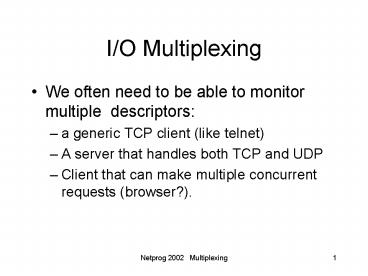IO Multiplexing - PowerPoint PPT Presentation
1 / 14
Title:
IO Multiplexing
Description:
Input from standard input should be sent to a TCP socket. ... Use alarm and signal handler to interrupt slow system calls. Use multiple processes/threads. ... – PowerPoint PPT presentation
Number of Views:31
Avg rating:3.0/5.0
Title: IO Multiplexing
1
I/O Multiplexing
- We often need to be able to monitor multiple
descriptors - a generic TCP client (like telnet)
- A server that handles both TCP and UDP
- Client that can make multiple concurrent requests
(browser?).
2
Example - generic TCP client
- Input from standard input should be sent to a TCP
socket. - Input from a TCP socket should be sent to
standard output. - How do we know when to check for input from each
source?
3
Generic TCP Client
STDIN
TCP SOCKET
STDOUT
4
Options
- Use nonblocking I/O.
- use fcntl() to set O_NONBLOCK
- Use alarm and signal handler to interrupt slow
system calls. - Use multiple processes/threads.
- Use functions that support checking of multiple
input sources at the same time.
5
Non blocking I/O
- use fcntl() to set O_NONBLOCK
- int flags
- flags fcntl(sock,F_GETFL,0)
- fcntl(sock,F_SETFL,flags O_NONBLOCK)
- Now calls to read() (and other system calls) will
return an error and set errno to EWOULDBLOCK.
6
- while (! done)
- if ( (nread(STDIN_FILENO,)lt0))
- if (errno ! EWOULDBLOCK)
- / ERROR /
- else write(tcpsock,)
- if ( (nread(tcpsock,)lt0))
- if (errno ! EWOULDBLOCK)
- / ERROR /
- else write(STDOUT_FILENO,)
7
The problem with nonblocking I/O
- Using blocking I/O allows the Operating System to
put your process to sleep when nothing is
happening (no input). Once input arrives, the OS
will wake up your process and read() (or
whatever) will return. - With nonblocking I/O, the process will chew up
all available processor time!!!
8
Using alarms
- signal(SIGALRM, sig_alrm)
- alarm(MAX_TIME)
- read(STDIN_FILENO,)
- ...
- signal(SIGALRM, sig_alrm)
- alarm(MAX_TIME)
- read(tcpsock,)
- ...
A function you write
9
Alarming Problem
- What will happen to the response time ?
- What is the right value for MAX_TIME?
10
Select()
- The select() system call allows us to use
blocking I/O on a set of descriptors (file,
socket, ). - For example, we can ask select to notify us when
data is available for reading on either STDIN or
a TCP socket.
11
select()
- int select( int maxfd,
- fd_set readset,
- fd_set writeset,
- fd_set excepset,
- const struct timeval timeout)
- maxfd highest number assigned to a
descriptor. - readset set of descriptors we want to read
from. - writeset set of descriptors we want to write to.
- excepset set of descriptors to watch for
exceptions. - timeout maximum time select should wait
12
struct timeval
- struct timeval
- long tv_sec / seconds /
- long tv_usec / microseconds /
- struct timeval max 1,0
13
fd_set
- Implementation is not important
- Operations you can use with an fd_set
- void FD_ZERO( fd_set fdset)
- void FD_SET( int fd, fd_set fdset)
- void FD_CLR( int fd, fd_set fdset)
- int FD_ISSET( int fd, fd_set fdset)
14
Using select()
- Create fd_set
- Clear the whole thing with FD_ZERO
- Add each descriptor you want to watch using
FD_SET. - Call select
- when select returns, use FD_ISSET to see if I/O
is possible on each descriptor.































